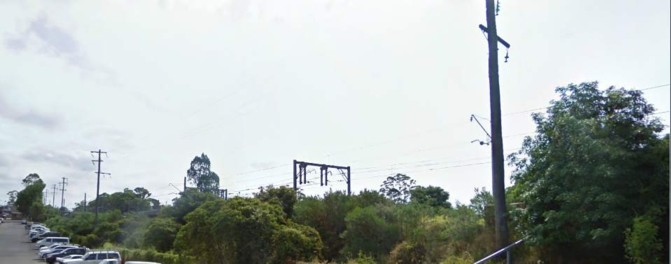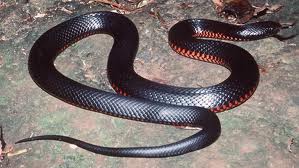Wild fruit
Recently someone was on the radio saying that rural kids in the Hunter Valley still harvest wild mulberries and can be seen with purple hands and mouths when the berries are in season. The implication seemed to be that they were running feral.
In my childhood wild fruit trees were everywhere around Thornleigh, particularly along the railway embankment; and almost everyone had fruit trees in their garden.
This was not the only incentive to climb trees.
Many of us spent considerable time in trees; where we built platforms, hunted cicadas, or simply climbed for the view or the breeze. There were occasional concussions, broken limbs or worse, as a result of falls, but most were relatively uneventful.
The wild fruit was not of good quality, children often picked it too soon and higher, harder to reach fruit that did ripen was often attacked by birds and bats. But that didn’t stop us picking and eating it or just throwing it at each other.

The same location today; one peach tree left. Railway Parade was once dirt, often with street Cricket; and not a car in sight.
Apart from mulberries there were peaches plums and apricots – mainly peaches and plums. There had once been commercial orchards in the area but these had suffered from fruit fly and the land was developed for other purposes. Among the cottages there were still a few grazing paddocks for horses, sheep or goats. Some commercial egg and pig growers remained and near our house was a small commercial sweet corn grower and market gardener. Most people also had a vegetable garden.
Further out towards the west there were commercial dairies, orchards for all kinds of fruit and flower growers.
We generally visited the fruit trees in season on the way home from school; during lunchtime when we would escape the school playground; or on sports afternoon if we didn’t like the sport being foist upon us.
School ended at 3pm and we would often not get home ‘til 5 or 6 or before dark (the curfew).
No search party was sent out; and as only a few parents had a telephone and even if they did (we had one) it cost twopence (tuppence) to call from a public box. That was a lot of money for a kid; for threepence (a trey) we could buy an ice-cream. For sixpence (a zack) you could go to the ficks (the movies) and see two films; plus a serial and some cartoons.
Of course you could dial home and then shout into the earpiece that hung separately on its own cord. The mouthpiece was on the phone body that housed the rotary dial and the money box.
Needless to say we felt no compulsion to do this regularly as we would ‘soon’ be home. As a result we were generally incommunicado for a couple of hours every day.
Mulberries were inedible until ripe then in such abundance that we ate them by the hand-full.
The leaves were basic food-stock for our silk worms. These started as tiny eggs, laid by last year’s moths and kept in rolled oats until they hatched as grubs (worms). Kept in a cardboard box the worms were fed on mulberry leaves; then cabbage, if you wanted white silk; or violet leaves, if you wanted purple.
After they had grown to around an inch in length they began to spin a cocoon, from the outside in, somewhere in the box. This became denser and denser until it was a small egg shaped ball of yellow silk. After some had been set aside for next year, the remaining cocoons were soaked in water and then the outer end of the strand carefully released.
This is where the Meccano was put to use to make a winding machine. Several strands from cocoons bobbing in their water were fed through holes in the meccano to the winding drum to make a silk thread. Hours of fun followed as threads tangled or broke before the winding machine was perfected. Then of course we lost interest – what can you do with silk thread? Build a loom?
Meters of thread lay in our big wooden Meccano box until years later; when it was finally thrown away. Meanwhile the kept cocoons were chewed open at one end by their metamorphosised moths that emerged to spread their wings and repeat the process.
Blackberries also grew wild and could completely cover a piece of fallow land. The thorns are vicious and children often sported scratched legs; as a result of reaching for those particularly luscious ones. The best way of getting to them was to get a sheet of corrugated iron or a wooden plank and throw it onto the bush (really a tangle of vines) so that we could walk out towards the middle.
We were careful to make a bit of noise and disturb the bush, particularly if it had been left quietly all day, to scare-off any basking snakes. There were often venomous red-belly black snakes and brown snakes around; and we were constantly told about tourniquets; cutting and sucking wounds (no longer recommended).
One time we were having lunch in the bush and a Kookaburra flew down so close we thought it was after our food; only to see it snatch-up a snake from about two yards away and carry it up into a tree to be whacked to death against a branch.

A red-bellied black snake - usually around a meter and a half in length.
They can be deadly but not as venomous as the, less pretty, brown snakes; also common in the Thornleigh bush.
Source: News.com - Snake turns up in sandpit at Primary School
But I was never bitten and I don’t recall any of my friends being bitten either. Spiders and a variety of insects were a different matter. Particularly nasty were big black and yellow bull ants.
